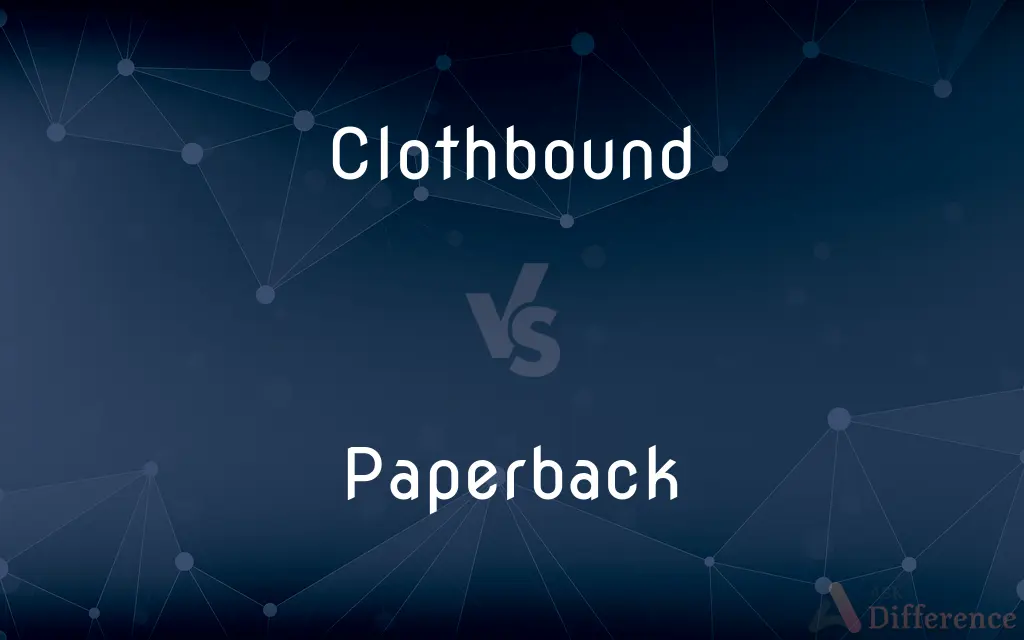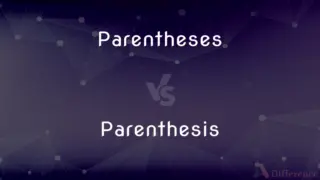Clothbound vs. Paperback — What's the Difference?
Edited by Tayyaba Rehman — By Maham Liaqat — Updated on April 2, 2024
Clothbound books feature durable fabric covers, often with stitched bindings for longevity, whereas paperbacks have flexible, paper-based covers for cost-effectiveness and portability.

Difference Between Clothbound and Paperback
Table of Contents
ADVERTISEMENT
Key Differences
Clothbound books are traditionally bound with a hard cover that is wrapped in cloth, which adds a layer of durability and aesthetic appeal. This makes them ideal for collectors and those looking for a more premium reading experience. On the other hand, paperbacks are characterized by their soft, flexible covers made from paper or cardboard, making them lighter and more affordable, but less durable over time.
The production of clothbound books involves more materials and labor, including the cloth covering and often additional features like embossing or foil stamping. This results in a higher cost but also a product that can withstand the test of time better than its counterpart. Paperbacks, while less costly to produce and purchase, may wear out more quickly, especially with frequent use or poor handling.
Collectors and libraries often favor clothbound editions for their longevity and the value they add to collections. The aesthetic and tactile qualities of clothbound books make them desirable items to own and display. Paperbacks, in contrast, are preferred for everyday reading and travel due to their lightweight and compact nature, even though they might not last as long or look as prestigious on a shelf.
When it comes to the resale market, clothbound books can retain or even increase in value over time, especially if they are first editions or have unique features. Paperbacks generally have less resale value, reflecting their initial lower purchase price and greater wear and tear. However, popular paperback titles can still be sought after in used book markets.
In terms of environmental impact, clothbound books require more resources for production, including the cloth and additional processing. This makes them less eco-friendly compared to paperbacks, which, while still consuming resources, typically use less material and are lighter, reducing transportation emissions.
ADVERTISEMENT
Comparison Chart
Cover Material
Fabric, often with additional protective layers.
Paper or lightweight cardboard.
Durability
Higher due to robust materials and construction.
Lower, prone to wear and tear.
Cost
Generally more expensive due to materials and labor.
More affordable, with fewer production costs.
Appeal
Preferred by collectors for aesthetic and longevity.
Favored for convenience and portability.
Environmental Impact
Greater due to more intensive production process.
Less, using fewer resources and easier to recycle
Compare with Definitions
Clothbound
Known for durability and a premium feel.
She prefers clothbound diaries for their lasting quality.
Paperback
A book with a soft paper or cardboard cover.
I bought a paperback version of the bestseller for my beach vacation.
Clothbound
A type of book binding that uses cloth to cover the outside of a book.
The library's rare collection includes several first editions with ornate clothbound covers.
Paperback
AMore affordable and accessible than hardcovers.
Students often prefer paperback textbooks for their lower cost.
Clothbound
Often chosen for special editions or library bindings.
The anniversary edition of the novel was released in a beautiful clothbound version.
Paperback
Known for being lightweight and portable.
She packed a few paperbacks in her bag for the long flight.
Clothbound
Appeals to collectors and enthusiasts.
Collectors often seek out clothbound classics for their personal libraries.
Paperback
Prone to wear and damage with heavy use.
His favorite paperback novel was frayed from being read so many times.
Clothbound
More expensive due to materials and labor.
Despite the higher price, the clothbound cookbook was irresistible.
Paperback
Widely used for mass-market publications.
The mystery novel was released as a paperback to reach a wider audience.
Clothbound
Having a cover of thick paper boards covered with cloth. Used of a book.
Paperback
A paperback, also known as a softcover or softback, is a type of book characterized by a thick paper or paperboard cover, and often held together with glue rather than stitches or staples. In contrast, hardcover or hardback books are bound with cardboard covered with cloth, plastic, or leather.
Clothbound
(publishing) Bound with cloth, as opposed to other bindings such as paper or leather.
Paperback
A book having a flexible paper binding.
Paperback
A book with flexible binding.
Paperback
(of a book) Having flexible binding.
Paperback
To issue or publish (a book) in a paperback edition.
Paperback
A book with paper covers; - contrasted with hardback or hardcover.
Paperback
Having a flexible binding; - of books. Contrasted to hardcover or hardbacked or hardbound.
Paperback
A book with paper covers
Paperback
(of books) having a flexible binding
Common Curiosities
What makes clothbound books more durable?
The fabric cover and stronger binding of clothbound books enhance their durability.
Are paperbacks less durable than clothbound books?
Yes, due to their softer covers and binding, they are more prone to wear.
Why are paperbacks more affordable?
Paperbacks have less expensive materials and simpler production processes, lowering their cost.
Can clothbound books be more environmentally impactful?
Yes, due to their more resource-intensive production process.
Why might a collector prefer clothbound books?
For their aesthetic appeal, durability, and potential for value appreciation.
Do clothbound books have a higher resale value?
Generally, yes, especially if they are collectible editions.
Do libraries prefer one type over the other?
Libraries might prefer clothbound for durability and longevity, especially for classics or frequently used titles.
Can the choice between clothbound and paperback affect an author's sales?
Yes, offering both can cater to different market preferences and potentially increase sales.
Are there environmental considerations in choosing between the two?
Yes, the environmental impact of production and end-of-life recyclability can influence the choice.
Are paperbacks easier to carry?
Yes, they are lighter and more flexible, making them easier to transport.
How do publishers decide which format to use for a book?
Decisions are based on market demand, cost, and the intended audience.
Is there a difference in the reading experience between the two?
The reading experience can vary; some prefer the feel and weight of clothbound books, while others like the portability of paperbacks.
Do paperbacks have any advantages over clothbound books besides cost?
Their lightweight and portability make them convenient for reading on the go.
Can both types of books coexist in a reader's collection?
Absolutely, as each serves different purposes and preferences for book lovers.
Is the production time different between the two types of books?
Yes, clothbound books can take longer to produce due to their complex binding and cover materials.
Share Your Discovery

Previous Comparison
Parentheses vs. Parenthesis
Next Comparison
Foetal vs. FetalAuthor Spotlight
Written by
Maham LiaqatEdited by
Tayyaba RehmanTayyaba Rehman is a distinguished writer, currently serving as a primary contributor to askdifference.com. As a researcher in semantics and etymology, Tayyaba's passion for the complexity of languages and their distinctions has found a perfect home on the platform. Tayyaba delves into the intricacies of language, distinguishing between commonly confused words and phrases, thereby providing clarity for readers worldwide.














































